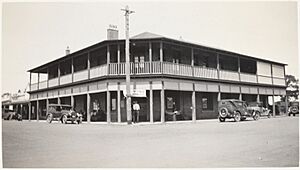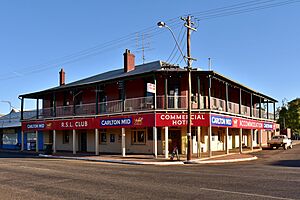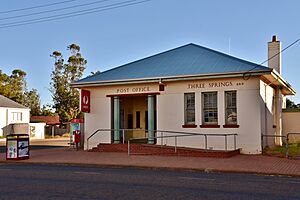Three Springs, Western Australia facts for kids
Quick facts for kids Three SpringsWestern Australia |
|||||||||
|---|---|---|---|---|---|---|---|---|---|

Three Springs railway station and grain silo, 2013.
|
|||||||||
| Established | 1906 | ||||||||
| Postcode(s) | 6519 | ||||||||
| Elevation | 257 m (843 ft) | ||||||||
| Area | [convert: needs a number] | ||||||||
| Location | |||||||||
| LGA(s) | Shire of Three Springs | ||||||||
| State electorate(s) | Moore | ||||||||
| Federal Division(s) | Durack | ||||||||
|
|||||||||
Three Springs is a small town in Western Australia. It is about 313 kilometers (194 miles) north of Perth, Western Australia. The town is on the Midlands Road. This road used to be the main route from Perth to the northern parts of the state. Three Springs is the main town for the Shire of Three Springs area. The town's economy mainly relies on farming and mining. Farmers grow grains and raise sheep here.
Contents
History of Three Springs
Early Explorers and Naming the Town
The first Europeans to explore near Three Springs were the Gregory brothers. They were government surveyors looking for new farming land. On September 14, 1846, they camped near Eneabba, which is southwest of Three Springs.
Later, in 1867, another government surveyor named Charles Cooke Hunt was mapping roads. He wrote "Three Springs" on his map after finding some springs nearby. This name then started appearing on official maps. Soon, people began to claim land in this area for farming.
The Railway and Town Development
In 1895, the Midland Railway was built. This railway connected Midland Junction to Walkaway. The railway company got land along the new tracks as part of the deal. Three Springs became a stop, or "siding," on this railway line.
In 1907, the government decided to create a town next to the railway siding. It was officially named Kadathinni in 1908. They planned to change the station's name too, but it was forgotten. So, the station stayed "Three Springs." People in the area also kept calling the town "Three Springs." In 1946, the town's official name was finally changed to Three Springs to match what everyone called it.
In 1932, the Wheat Pool of Western Australia announced a plan. They would build two large grain storage buildings, called elevators, at the railway siding. These elevators helped farmers store their crops.
Plants of Three Springs
The shrub Banksia trifontinalis is a special plant. It is also known as the Three Springs Dryandra. This plant was first found near the town. That is why it was named after Three Springs.
Economy and Industries
The economy of Three Springs is based on two main things: mining and agriculture. In agriculture, farmers grow a lot of grain and raise sheep. They also raise cattle and pigs. Sometimes, they grow wildflowers too.
Talc Mining in Three Springs
Imerys S.A. is a company from France. They run a large talc mine just outside Three Springs. This mine is the second largest talc mine in the world. Talc is a very soft mineral used in many products.
Before 2004, the talc was sent by train to Geraldton for export. But there was a problem with iron ore mixing with the talc at the port. So, since 2004, the talc is now transported by road.
Famous People from Three Springs
Three Springs has been home to some important people.
- James “Jimmy” Gardiner (1861-1928) was a local politician. He served in the Western Australian Parliament. He was also the state's treasurer and the first leader of the Country Party. James Gardiner was very involved in sports. He led the Western Australian Cricket Council and was president of the Western Australian Cricket Association. He also helped start local cricket and racing clubs in Three Springs.
- Patrick Lynch (1867-1944) was a farmer and a politician. He held important roles in both state and federal governments. He was the State Minister for Works. Later, he became the federal Minister for Works and Railways. He even served as the President of the Senate.






